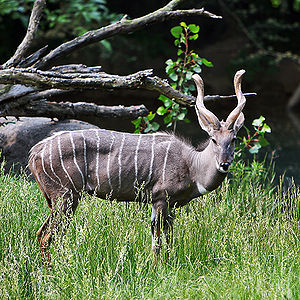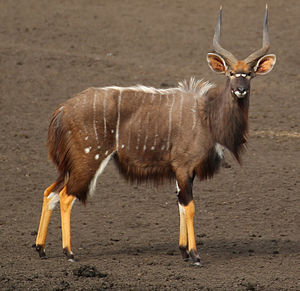Tragelaphus
This article needs additional citations for verification. (March 2013) |
| Tragelaphus | |
|---|---|

| |
| An adult male greater kudu by the Chobe River, Botswana | |
| Scientific classification | |
| Domain: | Eukaryota |
| Kingdom: | Animalia |
| Phylum: | Chordata |
| Class: | Mammalia |
| Order: | Artiodactyla |
| Family: | Bovidae |
| Subfamily: | Bovinae |
| Tribe: | Tragelaphini |
| Genus: | Tragelaphus (Blainville, 1816) |
| Type species | |
| Antilope sylvatica (= Antilope scripta)[1] Sparrman, 1780
| |
| Species | |
|
Tragelaphus angasii | |
Tragelaphus is a genus of medium-to-large-sized spiral-horned antelopes. It contains several species of bovines, all of which are relatively antelope-like. Species in this genus tend to be large in size and lightly built, and have long necks and considerable sexual dimorphism. Elands, including the common eland (Taurotragus oryx), are embedded within this genus, meaning that Taurotragus must be subsumed into Tragelaphus to avoid paraphyly. Alternatively, Taurotragus could be maintained as a separate genus, if the nyala and the lesser kudu are relocated to their own monospecific genera, respectively Nyala and Ammelaphus. Other generic synonyms include Strepsiceros (which applies to T. strepsiceros) and Boocercus (for T. eurycerus).[2] The name "Tragelaphus" comes from the mythical tragelaph.
Taxonomy and phylogeny
[edit]| Phylogenetic relationships of the mountain nyala from combined analysis of all molecular data (Willows-Munro et.al. 2005) |
Tragelaphus /trəˈdʒɛləfəs/ is a genus in the tribe Tragelaphini and the family Bovidae. The genus authority is French zoologist Henri Marie Ducrotay de Blainville, who first mentioned it in the journal Bulletin des Sciences, par la Société Philomatique in 1816.[1] The name is not of modern scientific invention, but comes from ancient Greek τραγέλαφος (tragélaphos), from τράγος (trágos), meaning a "male goat", and ἔλαφος (élaphos), meaning a "deer".[3]
Extant species
[edit]It is generally treated as having eight species, namely:[citation needed].
| Male | Female | Common name | Scientific name | Distribution |
|---|---|---|---|---|
 |
 |
Bongo | Tragelaphus eurycerus | Kenya, Central and western Africa |
 |
 |
Greater kudu | Tragelaphus strepsiceros | eastern and southern Africa |
 |
 |
Cape bushbuck | Tragelaphus sylvaticus | Cape in South Africa to Angola and Zambia and up the eastern part of Africa to Ethiopia and Somalia. |
 |
 |
Harnessed bushbuck | Tragelaphus scriptus | distributed from Senegal and southern Mauritania across the Sahel, east to Ethiopia, and south to Angola and the southern Democratic Republic of the Congo. |
 |
 |
Lesser kudu | Tragelaphus imberbis | Ethiopia, Kenya, Somalia, South Sudan, Tanzania, and Uganda |
 |
 |
Mountain nyala | Tragelaphus buxtoni | central Ethiopia. |
 |
 |
Lowland nyala or Nyala | Tragelaphus angasii | Eswatini, Malawi, Mozambique, South Africa, Zambia, and Zimbabwe. |
 |
 |
Sitatunga | Tragelaphus spekii | Democratic Republic of the Congo, the Republic of the Congo, Cameroon, parts of Southern Sudan, Equatorial Guinea, Burundi, Ghana, Botswana, Rwanda, Zambia, Gabon, the Central African Republic, Tanzania, Uganda and Kenya. |
An alternative classification, supported by genetic data, would recognise 11 species in five groups, which could be treated as subgenera or full genera: (i) Nyala for T. angasii; (ii) Ammelaphus for T. imberbis; (iii) Taurotragus for the two elands (T. oryx and T. derbianus); (iv) Strepsiceros for T. strepsiceros and (v) Tragelaphus restricted to T. buxtoni, T. spekei, T. scriptus, T. sylvaticus (Imbabala - separated from a polyphyletic T. scriptus) and T. eurycerus. In terms of divergence time estimates, a 2006 study showed that core Tragelaphus (now known to excude T. angasii and T. imberbis) diverged from Taurotragus (elands) towards the end of the Late Miocene.[4]
References
[edit]- ^ a b Wilson, D. E.; Reeder, D. M., eds. (2005). Mammal Species of the World: A Taxonomic and Geographic Reference (3rd ed.). Johns Hopkins University Press. ISBN 978-0-8018-8221-0. OCLC 62265494. Cite error: The named reference "MSW3" was defined multiple times with different content (see the help page).
- ^ Integrated Taxonomic Information System
- ^ "Tragelaphus". Merriam-Webster.com Dictionary. Merriam-Webster. Retrieved 7 February 2016.
- ^ Ropiquet, A. (2006). "Etude des radiations adaptatives au sein des Antilopinae (Mammalia, Bovidae)". Ph.D. Thesis, Université Paris. 6 (1–247).
